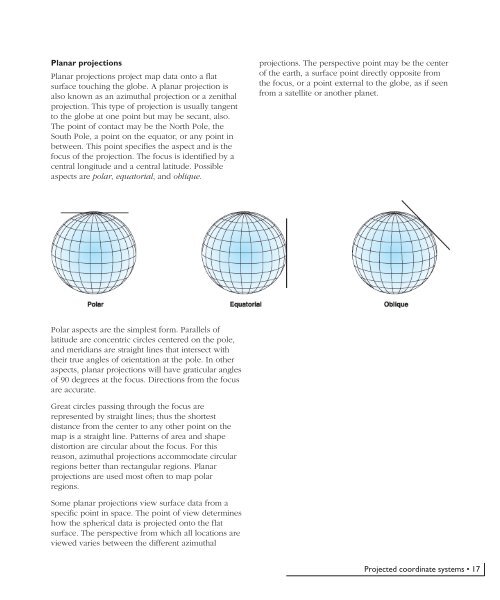Understanding Map Projections
Understanding Map Projections
Understanding Map Projections
- No tags were found...
You also want an ePaper? Increase the reach of your titles
YUMPU automatically turns print PDFs into web optimized ePapers that Google loves.
Planar projectionsPlanar projections project map data onto a flatsurface touching the globe. A planar projection isalso known as an azimuthal projection or a zenithalprojection. This type of projection is usually tangentto the globe at one point but may be secant, also.The point of contact may be the North Pole, theSouth Pole, a point on the equator, or any point inbetween. This point specifies the aspect and is thefocus of the projection. The focus is identified by acentral longitude and a central latitude. Possibleaspects are polar, equatorial, and oblique.projections. The perspective point may be the centerof the earth, a surface point directly opposite fromthe focus, or a point external to the globe, as if seenfrom a satellite or another planet.Polar aspects are the simplest form. Parallels oflatitude are concentric circles centered on the pole,and meridians are straight lines that intersect withtheir true angles of orientation at the pole. In otheraspects, planar projections will have graticular anglesof 90 degrees at the focus. Directions from the focusare accurate.Great circles passing through the focus arerepresented by straight lines; thus the shortestdistance from the center to any other point on themap is a straight line. Patterns of area and shapedistortion are circular about the focus. For thisreason, azimuthal projections accommodate circularregions better than rectangular regions. Planarprojections are used most often to map polarregions.Some planar projections view surface data from aspecific point in space. The point of view determineshow the spherical data is projected onto the flatsurface. The perspective from which all locations areviewed varies between the different azimuthalProjected coordinate systems • 17
















